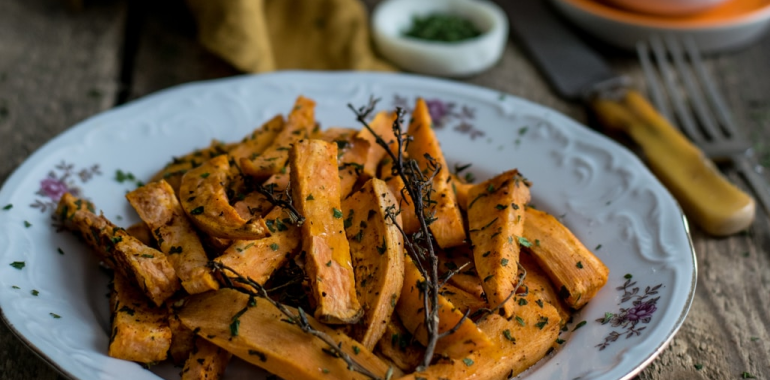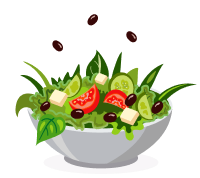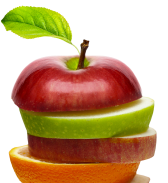Table Of Contents
A 100-gram serving of cooked sweet potatoes contains approximately 77 grams of water. Sweet potatoes are a great source of dietary water, which helps to maintain hydration and support various bodily functions.
The following table shows the nutrient of sweet potatoes and the recommended daily intake for adults.
The exact requirements will depend on age, gender, and activity levels.
Nutrition facts about sweet potato:
| Nutrients | Amount in 100g serving | Daily intakes recommended for adults |
|---|---|---|
| Calories | 86 kcal | 2000 kcal |
| Carbohydrates | 20.1 g | 130 g |
| Fiber | 3 g | 25 g |
| Protein | 1.6 g | 50 g |
| Fat | 0.1 g | 44-77 g |
| Vitamin A (as beta-carotene) | 14,187 IU | 700-900 mcg |
| Vitamin C | 2.4 mg | 90 mg |
| Potassium | 337 mg | 4700 mg |
| Iron | 0.7 mg | 8-18 mg |
| Calcium | 30 mg | 1000-1300 mg |
| Daily Intake of Sweet Potato | — | 1-2 cups (1 cup = about 200-240 g) |
*Note: The recommended daily intake of sweet potato is based on the USDA dietary guidelines for adults, which recommends consuming 1-2 cups of starchy vegetables per day. The serving size of 1 cup is approximately 200-240 grams.
Batats also contain B vitamins, calcium, and other essential vitamins and minerals. Eating sweet potato peel can increase its nutrient value. The color of its skin varies from white to yellow and purple to brown. However, whatever the color, it will provide additional nutrients. The protein in sweet potato is within 2g or more.
Also read – Psychology of Eating: How Food Affects Mood
Some variants of sweet potatoes include:
- White sweet potato
- Brown sweet potato
- Yellow sweet potato
- Purple sweet potato
Cooked sweet potato: what cooking method to choose?
Are you thinking of boiling sweet potatoes? Roasting sweet potatoes may be the most popular way to cook these tubers. But here’s the thing: cooking is the fastest! This technique is much quicker than grilling and is excellent for including them in a filling or garnishing another recipe. Most people think about roasting sweet potatoes when cooking this vegetable. But do you need the fastest way to cook sweet potatoes? It’s boiling all the way through.
Some advantages and disadvantages of this method:
- Boiled sweet potatoes are great when you want to make an enchilada, taco filling, or pizza topping and don’t want to turn on the oven. Also great for mashed sweet potatoes or as a quick side dish.
- The potatoes come out perfectly tender and moist. To flavor the best, you will need to season with some olive oil, butter, salt, and pepper.
- Boiling doesn’t caramelize like roasting, and the flavor isn’t as sweet. You won’t get those nice golden edges like baked potatoes.

Top-3 most popular sweet potato recipes
- Sweet Potato Fries are an easy and tasty treat to make! Just cut your sweet potatoes into thin strips, drizzle with olive oil & sprinkle with salt – pop them in the oven until they’re nice and crispy. Serve with your favorite dipping sauce for a delicious snack!
- Sweet Potato Casserole: Mash boiled sweet potatoes with butter, brown sugar, cinnamon, and nutmeg. Spread the mixture into a baking dish and top with a mixture of chopped pecans, flour, butter, and more brown sugar. Bake until golden and bubbly.
- Sweet Potato Pie: Mix mashed sweet potatoes with eggs, milk, sugar, and spices like cinnamon and nutmeg. Pour the mixture into a pie crust and bake until set. Serve with whipped cream on top.
Nutritional breakdown of a fried sweet potato
Serving Size – 1 medium-sized (5 inches long) fried sweet potato:Nutrient Amount Total Fat 8g Saturated Fat 1g Trans Fat 0g Polyunsaturated Fat 2g Monounsaturated Fat 4g Cholesterol 0mg Sodium 260mg Total Carbohydrate 28g Dietary Fiber 4g Sugars 6g Protein 2g Vitamin A 438% DV Vitamin C 9% DV Potassium 15% DV Iron 2% DV Calcium 4% DV
*Note: “DV” stands for “Daily Value,” which is the percentage of the recommended daily intake of that nutrient. The % DV is based on a 2000-calorie diet. However, it is important to note that frying sweet potatoes adds a significant amount of calories and fat compared to other cooking methods, such as baking or boiling.
Are sweet potatoes healthy?
There are hundreds of types of sweet potatoes. Some have white or cream-colored flesh.
Others are yellow, red, or purple. The “Covington” is the variety you are most likely to find in the store. It has pink skin and bright orange flesh.
A single sweet potato gives you 400% of the vitamin A you need every day. This helps keep your eyes healthy and your immune system, your body’s defense against germs. It’s also good for your reproductive plans and organs like your heart and kidneys.
Sweet potatoes are rich in:
- B vitamins
- Vitamin C
- Calcium
- Iron
- Magnesium
- Phosphorus
- Potassium
- Thiamin
- Zinc
Natural compounds called carotenoids give sweet potatoes their rich color. Carotenoids are also antioxidants, meaning they have the power to protect cells from daily damage.
Also, read – How to Stop Overeating
Is a sweet potato a vegetable?
Sweet potatoes are starchy vegetables because of their high-carb content, which provides an energy boost.
Health benefits
Sweet potatoes have earned the name “superfood” due to the number of nutrients they contain. Studies show they can help with:
- Cancer. Carotenes in sweet potatoes may reduce cancer risk. Purple sweet potatoes are rich in compounds called anthocyanin that could reduce the chances of getting colorectal cancer.
- Diabetes. Compounds in sweet potatoes might help control blood sugar. When boiled, sweet potatoes have a low glycemic index (GI), which means they won’t raise your blood sugar as quickly as high-GI foods.
- Heart disease. Sweet potatoes can lower LDL cholesterol, reducing the chances of heart problems.
- Macular degeneration. High amounts of beta-carotene and vitamin A, found in sweet potatoes, can reduce the chances of getting this eye disease, which is the most common cause of vision loss.
- Obesity. Purple sweet potatoes can help reduce inflammation in your body and prevent the growth of fat cells, which can help you lose weight.

What are the possible side effects of eating too many sweet potatoes?
Sweet potatoes are an excellent source of vitamins and minerals, yet over-consumption of them can cause certain risks. Awareness is key when it comes to eating sweet potatoes as too much could lead to some negative effects, such as:
- Increased risk of kidney stones: Eating large quantities of sweet potatoes can lead to an elevated level of oxalates, which can be a risk factor for kidney stones.
- Digestive discomfort: Eating too many sweet potatoes can potentially lead to digestive problems such as bloating, gas, and diarrhea due to their high fiber content. It is important to consume them in moderation.
- Elevated blood sugar levels: Sweet potatoes are a good source of complex carbohydrates, but consuming large amounts can cause a rapid increase in blood sugar levels, which can be problematic for people with diabetes.
- Skin discoloration: Ingesting too many sweet potatoes can lead to carotenemia, which presents itself as a yellow or orange tint on the skin.
- Vitamin A toxicity: Sweet potatoes are high in vitamin A, and excessive intake of this nutrient can lead to toxicity, causing symptoms such as nausea, dizziness, and skin irritation.
It is important to consume sweet potatoes in moderation and as part of a balanced and varied diet in order to avoid any side effects. As with any food, it is always best to consult with a healthcare professional or registered dietitian for personalized dietary advice.
Sweet potato and IF: can you eat sweet potatoes on intermittent fasting?
Intermittent fasting has become a popular way to maintain your health, focus on important tasks and lose extra pounds. It consists of alternating between periods of eating and abstaining from food. One of the most used methods is by restricting meals to an 8-hour window in a day and then fasting for 16 hours.
Sweet potatoes are a powerhouse of nutrition, making them the perfect food to include in your diet during intermittent fasting. Loaded with fiber, vitamins, and minerals, they can help provide sustained energy throughout the fasting period – all while keeping you healthy and fit!
If you’re looking to include sweet potatoes in your intermittent fasting plan, be mindful of the timing and quantity. Sweet potatoes can be included as part of a meal or snack during your eating window – so take advantage! Despite the immense health benefits of sweet potatoes, it is important to enjoy them in moderation. As they are starchy vegetables, they can be quite high in carbs, and calories, so it’s best to consume them wisely!
Intermittent fasting is a great way to improve your health, but it’s important to find a plan that works for you. Everyone is different and it is always advised to speak with your doctor or healthcare provider before starting any new diet or fasting program.
Does sweet potato have fiber?
Sweet potatoes are rich in fiber, especially if you keep the skin on; sweet potatoes make an excellent base for vegetarian meals and are versatile enough to be used in snacks, desserts, smoothies, and other dishes.
A medium-cooked skinless sweet potato has about 105 calories and 4 grams of dietary fiber. Mashed sweet potato pulp has about 3 grams of fiber in 1/2 cup, and a slice of sweet potato pie has only 1 gram of fiber.
A medium-baked sweet potato has almost the same amount of soluble and insoluble fiber, about 2 grams of each type. While soluble fiber can help lower cholesterol levels, insoluble fiber helps food pass through the stomach and intestines and is especially beneficial for good intestinal health.











Thank you for sharing these amazing sweet potato recipes and info about how many sweet potatoes can you eat a day! Your instructions make it sound so simple, delicious, and healthy.
Hi, Emma👋
It’s great that the article provided helpful content for you!